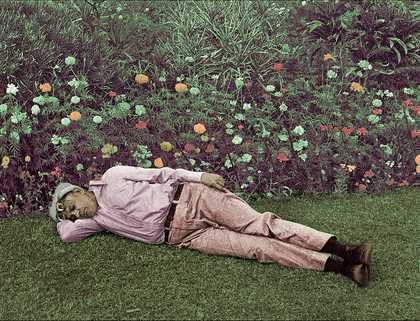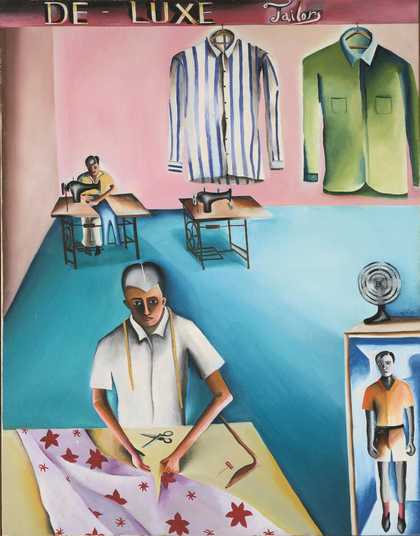
Bhupen Khakhar De-Lux Tailors 1972 Howard Hodgkin Collection
© Estate of Bhupen Khakhar
1. He drew inspiration from popular culture
Drawn towards bold colours and kitsch objects, Bhupen Khakhar referenced both high and low forms of visual culture in his work. In 1960s India, popular culture was largely disregarded by artists, but he collected prints, toys and cheap figurines, and lined the walls of his home and studio with this collection, getting inspiration for his works.
Part of a lively community of artists and writers, including Gulam Mohammed Sheikh, Vivan Sundaram and the critic Geeta Kapur, Khakhar was involved in debates on art and aesthetics. In 1962 he shared housing with British artist Jim Donovan, who introduced him to British pop art and the work of David Hockney and R.B. Kitaj. Khakhar’s use of colour and some of his amateurishly-painted faces recall Hockney’s work.
Throughout the 1970s Khakhar produced his series of ‘trade paintings’, portraying the lives of local workers and tradesmen in Baroda (now Vadodara). Painted with vibrant oil paint, reflecting bazaar shop fronts and bourgeois homes, these paintings were considered by some to represent ‘bad taste’ which Khakhar reveled in. As a chartered accountant by day and an artist by night, Khakhar empathised and identified with ordinary people. This series reflects Khakhar’s dedication to illustrating the world around him and representing the different classes that he interacted with in Baroda.
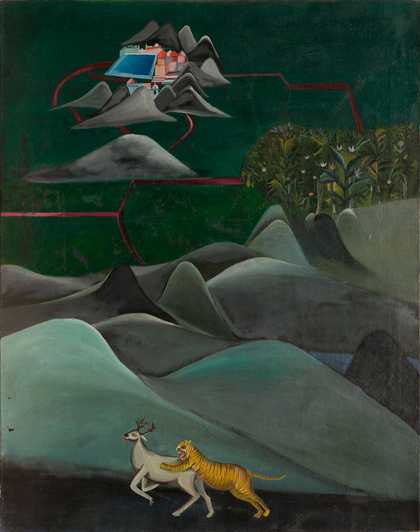
Bhupen Khakhar Tiger and Stag 1970 Estate of Bhupen Khakhar/ National Gallery of Modern Art (NGMA), New Delhi
© Estate of Bhupen Khakhar
2. But he was also influenced by art history
By combining art-historical influences with contemporary culture, Khakhar created a style of his own. Indian miniatures, folk art, Kalighat painting, Company painting, temple maps, 14th-century Sienese painting and pop art all added to his visual repertoire.
In the art world Bhupen Khakhar is regarded as a legend, a pioneer.
Former Director of Tate Modern, Chris Dercon
He was also inspired by the French, ‘primitivist’ painter Henri Rousseau, saying: ‘because of my awkwardness, I could relate to him’.
Khakhar played a significant role in a new wave of narrative and figurative painting emerging in contemporary Indian art. In turn he became a key figure in international 20th century painting and influenced many younger artists, including Atul Dodiya.

Bhupen Khakhar Man with Cataracts 1989 Ink on paper, Private Collection
© Estate of Bhupen Khakhar
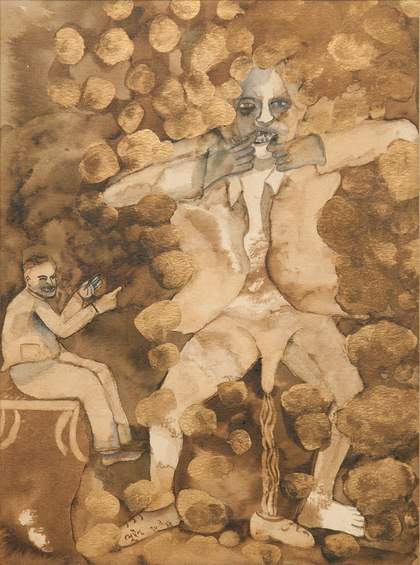
Bhupen Khakhar Idiot 2003 Collection of Brian Weinstein
© Estate of Bhupen Khakhar
3. He believed that artists should reflect their own vulnerability in their paintings
Throughout his career he confronted provocative and personal themes, such as his sexuality and battle with cancer, with humour, honesty and wit.
One can’t hide oneself behind a painting. It is standing naked in front of everyone – what are you are.
Bhupen Khakhar
Having come out as a gay man and witnessed the development of the gay rights movement in Europe, Bhupen felt encouraged to deal explicitly with homoerotic themes within his work. There is a confessional element to his art, with many of the paintings illustrating his own sexual desires. Bhupen viewed painting as an act of love. The love he felt for his subjects is transformed into the careful act of painting.
When, in the early 1990s, Khakhar suffered from cataracts he adopted a looser, blurry style of brushwork as his eyesight deteriorated. After his recovery, his work regained detail and precision. After his prostate cancer diagnosis, the tone of his work changed, focusing on universal themes of mortality and ageing.
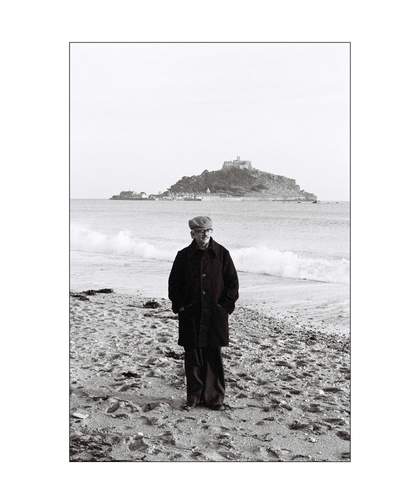
Khakhar in Cornwall c.1979
Photograph by Anthony Stokes
4. He was cosmopolitan
In 1976 he travelled to the USSR, Italy and the UK, where he was later invited to teach at the Bath Academy of Art. During this time he stayed with the British painter Howard Hodgkin in Wiltshire and was introduced to the British pub scene, inspiring the painting on display Man in Pub 1979.
When describing his time in England, Bhupen once wrote:
You are not allowed to smile during this season which lasts for ten months of the year. If you are sensible then try to look as grumpy as possible. English people appreciate sulk.
In 1994 Khakhar took up a residency at the European Ceramic Work Centre in the Netherlands. There he experimented with ceramics, creating three-dimensional objects and using the glaze in a painterly manner. Alongside sculptures you’ll also see his glazed bowls and plates featuring portraits and whimsical scenes.
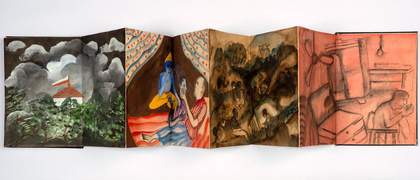
Bhupen Khakhar, Title not known c.1990 Accordion pleated book, Lekha and Anupam Poddar Collection
© Estate of Bhupen Khakhar
Photo: Pablo Bartholomew
5. Lastly, he was a great storyteller
Also a writer, Khakhar illustrated his own short stories, a volume for Salman Rushdie, and wrote a play that was performed with sets that he designed and painted.
The book Visit to Sri Lanka was produced by Khakhar upon returning from his final trip abroad to Sri Lanka in 2003, just nine months before his death. Too frail to join many of the expeditions, Bhupen would instead sketch and create images painted from memory, experienced first-hand and taken from postcards. These paintings reveal Khakhar’s determination to create his artwork.
Khakhar’s strong imagination and sense of humour stretched into his personal life. While he never married, Khakhar invented for himself an imaginary family, often complaining about his quarrelsome wife and good-for-nothing sons!

